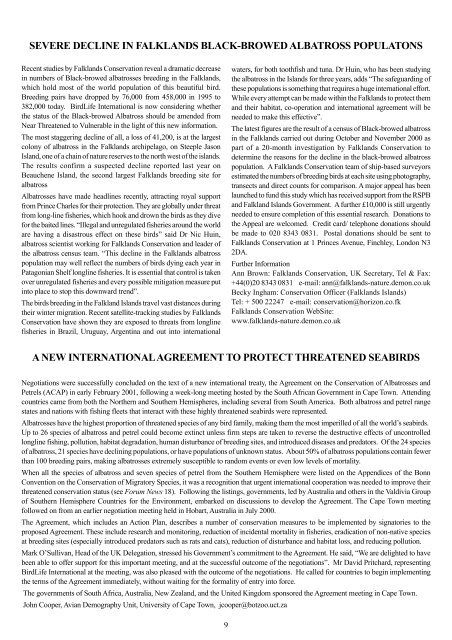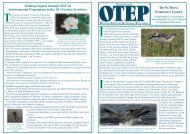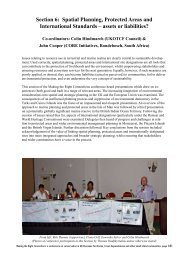Issue 20 - UKOTCF
Issue 20 - UKOTCF
Issue 20 - UKOTCF
You also want an ePaper? Increase the reach of your titles
YUMPU automatically turns print PDFs into web optimized ePapers that Google loves.
SEVERE DECLINE IN FALKLANDS BLACK-BROWED ALBATROSS POPULATONS<br />
Recent studies by Falklands Conservation reveal a dramatic decrease<br />
in numbers of Black-browed albatrosses breeding in the Falklands,<br />
which hold most of the world population of this beautiful bird.<br />
Breeding pairs have dropped by 76,000 from 458,000 in 1995 to<br />
382,000 today. BirdLife International is now considering whether<br />
the status of the Black-browed Albatross should be amended from<br />
Near Threatened to Vulnerable in the light of this new information.<br />
The most staggering decline of all, a loss of 41,<strong>20</strong>0, is at the largest<br />
colony of albatross in the Falklands archipelago, on Steeple Jason<br />
Island, one of a chain of nature reserves to the north west of the islands.<br />
The results confirm a suspected decline reported last year on<br />
Beauchene Island, the second largest Falklands breeding site for<br />
albatross<br />
Albatrosses have made headlines recently, attracting royal support<br />
from Prince Charles for their protection. They are globally under threat<br />
from long-line fisheries, which hook and drown the birds as they dive<br />
for the baited lines. “Illegal and unregulated fisheries around the world<br />
are having a disastrous effect on these birds” said Dr Nic Huin,<br />
albatross scientist working for Falklands Conservation and leader of<br />
the albatross census team. “This decline in the Falklands albatross<br />
population may well reflect the numbers of birds dying each year in<br />
Patagonian Shelf longline fisheries. It is essential that control is taken<br />
over unregulated fisheries and every possible mitigation measure put<br />
into place to stop this downward trend”.<br />
The birds breeding in the Falkland Islands travel vast distances during<br />
their winter migration. Recent satellite-tracking studies by Falklands<br />
Conservation have shown they are exposed to threats from longline<br />
fisheries in Brazil, Uruguay, Argentina and out into international<br />
waters, for both toothfish and tuna. Dr Huin, who has been studying<br />
the albatross in the Islands for three years, adds “The safeguarding of<br />
these populations is something that requires a huge international effort.<br />
While every attempt can be made within the Falklands to protect them<br />
and their habitat, co-operation and international agreement will be<br />
needed to make this effective”.<br />
The latest figures are the result of a census of Black-browed albatross<br />
in the Falklands carried out during October and November <strong>20</strong>00 as<br />
part of a <strong>20</strong>-month investigation by Falklands Conservation to<br />
determine the reasons for the decline in the black-browed albatross<br />
population. A Falklands Conservation team of ship-based surveyors<br />
estimated the numbers of breeding birds at each site using photography,<br />
transects and direct counts for comparison. A major appeal has been<br />
launched to fund this study which has received support from the RSPB<br />
and Falkland Islands Government. A further £10,000 is still urgently<br />
needed to ensure completion of this essential research. Donations to<br />
the Appeal are welcomed. Credit card/ telephone donations should<br />
be made to 0<strong>20</strong> 8343 0831. Postal donations should be sent to<br />
Falklands Conservation at 1 Princes Avenue, Finchley, London N3<br />
2DA.<br />
Further Information<br />
Ann Brown: Falklands Conservation, UK Secretary, Tel & Fax:<br />
+44(0)<strong>20</strong> 8343 0831 e-mail: ann@falklands-nature.demon.co.uk<br />
Becky Ingham: Conservation Officer (Falklands Islands)<br />
Tel: + 500 22247 e-mail: conservation@horizon.co.fk<br />
Falklands Conservation WebSite:<br />
www.falklands-nature.demon.co.uk<br />
A NEW INTERNATIONAL AGREEMENT TO PROTECT THREATENED SEABIRDS<br />
Negotiations were successfully concluded on the text of a new international treaty, the Agreement on the Conservation of Albatrosses and<br />
Petrels (ACAP) in early February <strong>20</strong>01, following a week-long meeting hosted by the South African Government in Cape Town. Attending<br />
countries came from both the Northern and Southern Hemispheres, including several from South America. Both albatross and petrel range<br />
states and nations with fishing fleets that interact with these highly threatened seabirds were represented.<br />
Albatrosses have the highest proportion of threatened species of any bird family, making them the most imperilled of all the world’s seabirds.<br />
Up to 26 species of albatross and petrel could become extinct unless firm steps are taken to reverse the destructive effects of uncontrolled<br />
longline fishing, pollution, habitat degradation, human disturbance of breeding sites, and introduced diseases and predators. Of the 24 species<br />
of albatross, 21 species have declining populations, or have populations of unknown status. About 50% of albatross populations contain fewer<br />
than 100 breeding pairs, making albatrosses extremely susceptible to random events or even low levels of mortality.<br />
When all the species of albatross and seven species of petrel from the Southern Hemisphere were listed on the Appendices of the Bonn<br />
Convention on the Conservation of Migratory Species, it was a recognition that urgent international cooperation was needed to improve their<br />
threatened conservation status (see Forum News 18). Following the listings, governments, led by Australia and others in the Valdivia Group<br />
of Southern Hemisphere Countries for the Environment, embarked on discussions to develop the Agreement. The Cape Town meeting<br />
followed on from an earlier negotiation meeting held in Hobart, Australia in July <strong>20</strong>00.<br />
The Agreement, which includes an Action Plan, describes a number of conservation measures to be implemented by signatories to the<br />
proposed Agreement. These include research and monitoring, reduction of incidental mortality in fisheries, eradication of non-native species<br />
at breeding sites (especially introduced predators such as rats and cats), reduction of disturbance and habitat loss, and reducing pollution.<br />
Mark O’Sullivan, Head of the UK Delegation, stressed his Government’s commitment to the Agreement. He said, “We are delighted to have<br />
been able to offer support for this important meeting, and at the successful outcome of the negotiations”. Mr David Pritchard, representing<br />
BirdLife International at the meeting, was also pleased with the outcome of the negotiations. He called for countries to begin implementing<br />
the terms of the Agreement immediately, without waiting for the formality of entry into force.<br />
The governments of South Africa, Australia, New Zealand, and the United Kingdom sponsored the Agreement meeting in Cape Town.<br />
John Cooper, Avian Demography Unit, University of Cape Town, jcooper@botzoo.uct.za<br />
9







